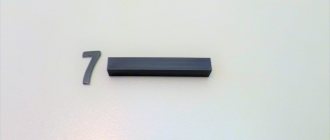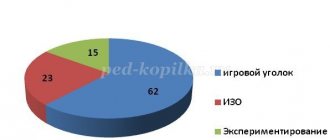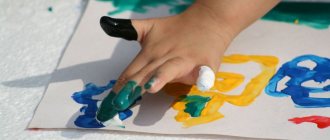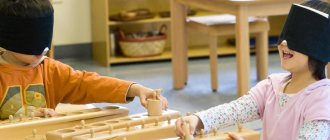Mathematics for preschoolers on Cuisenaire sticks. Where to start getting acquainted with chopsticks?
We offer you an overview of the exercises recorded at the webinar by the author of educational games, Bella Borisovna Finkelshtein.
Believe it or not, all the math concepts a child learns from 2nd through Pre-K can be illustrated using colored counting sticks.
Let's show this in basic game exercises.
Simple math concepts:
One and many. Many and one.
Where is one? Where is there a lot?
Comparison of sets. More less; longer is shorter.
We show the concept of equality on sticks.
Concept of numbers.
Each stick has a name, it is written
is expressed in numbers. (Cardboard numbers and signs are included with the game.)
Let's sign the blue stick, and the pink one... What's the name of the red stick, let's find a number for it!
Composition of numbers from units. How many units are in a number, so is the number.
Children's research activity: determine how many units are in a pink stick, in a black stick. The length of each stick can be indicated by a number, and when comparing, use the signs ><=
We form the idea of more, less. How much more (less). Equalization.
| 3 is more than 2 by 1 | 6 is less than 7 by 1 |
Natural series. Construction of natural series.
First stage: we build a row up to 5, the second stage - from 5 to 10. We build rows in two planes - vertical and horizontal.
Let's build a ladder! (What's the next step? Let's count! (one, two, three....)
Another research work is to prove that each subsequent number is 1 more or 1 less than the previous one.
Sticks can be combined into families:
| White family: | Black family: |
| Red family: | Blue family: |
| Yellow family: | |
| It may be noted that some numbers are included in several families. As you guessed, families combine numbers that are multiples of 2,3,5 and prime numbers. One and seven - families - singles. |
7. Composition of a number from two smaller ones.
A very effective exercise for consolidating the composition of a number from two smaller ones.
Children will not only remember the composition, but also choose the number themselves and feel the composition tactilely.
Example exercises:
We will weave rugs.
Let's weave a carpet. Let's fold the number 7 carpet:
Or we'll assemble a runway for an airplane...
It is useful to write down (code) your rug using numbers. Decoding is also interesting.
Solution of examples:
We supplement the solution of the examples with numbers and signs.
| Addition. | Subtraction: |
Drawing up problems based on models.
Children are happy to come up with problems using the proposed models for addition and subtraction.
7 sparrows were sitting on a branch, 2 more sparrows flew in, how many sparrows are sitting on the branch? There were 7 cars in the parking lot, 2 more parked.... etc. Children's imagination is limitless. What will your task be about?
Prepare to understand the operations of multiplication and division.
| Multiplication: How many rows? How many in one row? How much in total? | Division: Two is the measure of an object. |
11. Going through ten.
In many languages, the numbers of the second ten sound the same: five times ten. We take Ten (twenty) and put five on it. That makes fifteen.
Let's make thirteen, seventeen from sticks!
Names of numbers that are multiples of ten. Fifty - five tens.
What does thirty look like? or eighty?
We saw the possibilities of using sticks to solve arithmetic problems.
Consider the use of sticks in geometry.
Square.
Research work: prove that all sides of a square are equal. (Take a measurement and apply it to each side).
Rectangle. We prove the equality of opposite sides.
Triangle. We count the number of angles and sides.
Polygons, angles: right, acute, obtuse.
All of these exercises can be gradually introduced as part of a lesson (GCD).
For use in classes, you will need one box of colored Cuisenaire counting sticks for 2-3 people.
And, of course, in the educational process we use games and manuals that allow you to systematically work with colored Cuisenaire counting sticks.
| Younger age | Average age | Older age |
On the channel:
Games and exercises with Cuisenaire sticks
Sticks can be offered to children from three years of age to perform the simplest exercises. They can be used in the second junior, middle, senior and preparatory groups of kindergarten. Children can practice with sticks individually or several people in small subgroups.
In games with sticks, which can be competitive in nature, the child should be given the opportunity to exercise independence in finding a solution or answer to the question posed, learn to make assumptions and check them, and carry out practical and mental tests. It is better to help the child in indirect form, offering to think again, but in a different way, to try to complete the task, approving the correct actions and judgments of the children.
According to the level of complexity, exercises with Cuisenaire sticks should be divided into two stages.
At the first stage, sticks are used as playing material. Children play with them as with ordinary cubes and sticks and create various configurations. They are attracted to specific images, as well as the qualitative characteristics of the material - color, size, shape.
At the second stage, sticks act as a means of teaching arithmetic. Spatial-quantitative characteristics are not as obvious to children as color, shape, size. They can be opened in the joint activity of an adult and a child. At the same time, the adult is not limited to externally showing and reading ready-made configurations, but gives the child the opportunity to choose the action. Then the game will be a joyful discovery of something new. The child will quickly learn to translate (decode) the play of colors into numerical relations, to comprehend the laws of the mysterious world of numbers.
Game tasks for children 4-5 years old:
- Let's get acquainted with chopsticks. Together with your child, look at, sort through, touch all the sticks, tell them what color and length they are.
- Take as many sticks as possible in your right hand, and now in your left.
- You can lay out paths, fences, trains, squares, rectangles, pieces of furniture, various houses, garages from sticks on a plane.
- We lay out a ladder of 10 Cuisenaire sticks from the smallest (white) to the largest (orange) and vice versa. Walk your fingers along the steps of the ladder, you can count out loud from 1 to 10 and back.
- We lay out the ladder, passing 1 stick at a time. The child needs to find a place for the missing sticks.
- You can build three-dimensional buildings from sticks, like from a construction set: wells, turrets, huts, etc.
- We arrange the sticks by color and length.
- “Find a stick the same color as mine. What color are they?"
- “Put down the same number of sticks as I have.”
- “Lay out the sticks, alternating them by color: red, yellow, red, yellow” (later the algorithm becomes more complicated).
- Lay out several Cuisenaire counting sticks, invite the child to memorize them, and then, while the child is not looking, hide one of the sticks. Children must guess which stick has disappeared.
- Lay out several sticks and ask them to remember their relative positions.
- and swap them. The children need to return everything to its place.
- Lay out two sticks: “Which stick is longer? Which one is shorter? Place these sticks on top of each other, aligning the ends, and check.
- Place several Cuisenaire sticks in front of the child and ask: “Which is the longest? Which is the shortest?
- “Find any stick that is shorter than the blue one and longer than the red one.”
- Place the sticks into 2 piles: one has 10 pieces, and the other has 2. Ask where there are more sticks.
- Ask to show you a red stick, blue, yellow.
- “Show me the stick so it’s not yellow.”
- Ask to find 2 absolutely identical Cuisenaire rods. Ask: “How long are they? What color are they?"
- · List the colors of all the sticks on the table.
- · Show a stick that is not red, not yellow, etc.
- · Select sticks of the same color and use them to build a fence, a doll’s house, a garage, etc.
- · Take the blue and red sticks and place their ends towards each other. It turned out to be a train. Make a train of white and blue; red, green and blue; blue, orange and gray; brown, green, white and yellow sticks.
- · Find long and short sticks in the set. Name their colors. Place them on top of each other. Place them next to each other.
- · Choose two sticks of the same color. What length are they? Choose sticks of the same length. What color are they?
- · Take a red and a yellow stick (or any two other sticks of different colors). Place them on top of each other so that the long stick is at the bottom and the short stick is at the top.
- · Which stick is longer (shorter): red or brown, orange or blue, yellow or green? Place the sticks next to each other (overlay them on top of each other) and, aligning the ends on one side, check your answer.
- · Show some stick that is shorter than the blue one, longer than the brown one, shorter than the yellow one, etc.
- · Name and show all the sticks longer (shorter) ... (the color of any stick is called).
- · Make a ladder using red, green and brown sticks. Climb the stairs, naming the color of each step. Also go down the steps.
- · Take one stick of each color, place them in order from low to high (in a vertical plane). Make another row of sticks next to it, but in a different order - from long stick to short one. Now make one out of two rows (combining them with each other). List the colors of the sticks from left to right and right to left.
- · Make one stick from yellow and blue so that the yellow is on the right (from orange and green so that the orange is to the left of the green; from white, red and yellow so that the white is in the middle; in the second stage, the sticks act as a means of teaching arithmetic
Game tasks for children 5-7 years old.
- · Take the shortest stick. What color is it? The white stick is a unit, the number “one”.
- · Take the shortest stick. Move the white sticks close to each other so that it looks like they are one stick. Look for a stick in the set that is exactly the same length as two sticks put together. The red stick is the number two because it is the same length as the two white ones.
- · Find a stick equal in length to three white sticks. Three white sticks put together are equal in length to the green one. The green stick is the number “three” (by analogy, all other numbers up to 10 are entered).
- · Exercise in a game form “Name the number - find the stick.” The host calls the number and the players find the corresponding stick. Then the presenter shows the stick, and the children name the number that it represents (for example: white - one, red - two, green - three, brown - four, and so on). First, the numbers are called and the sticks are shown in order, and then broken down.
- · Exercise in the form of a game “Find a pair”. Options:
(1) You need to select a numerical figure for the colored number (stick) (the number is depicted on the card in the form of circles linearly, and then in the form of a geometric figure: square, triangle, circle).
(2) A colored number is matched with the corresponding regular number shown on the card.
(3) The corresponding number of objects (or their images on the card) is matched to the colored number.
- Take any stick from the set. Find two others that, when put together, will be equal in length to the first stick. Tell me what you did. Next to the sticks, place cards with numbers (or numerical figures) and signs (+, =).
- Take two sticks from the set and place them together at the ends. Find a stick equal in length to them. Remove one stick from two. Tell me what you did. “Write it down” using cards with numbers and signs (-, =). (All subsequent exercises, when possible, may include “recording” actions using cards with numbers and signs, but can be performed without this. Where and when it is best to use numbers and signs, the teacher decides, taking into account the individual characteristics of the child and his level of development ).
- I will take a long stick, and you find two others, shorter ones, so that, when put together, they will be equal in length to my stick. Continue making a carpet of several sticks. Options of varying complexity:
(1) The carpet is made from any sticks without any conditions.
(2) The carpet is made from as many strips as possible.
(3) The carpet is made from strips of different colors (the same sticks can be laid in different sequences).
(4) The carpet is made up of sticks of a certain color (for example: you need to take only red, green and yellow) or only from a certain number of them (only two, three, and so on).
(5) You need to make a fringe of white sticks for the carpet.
(6) What is laid out from sticks is “written down” using cards with numbers and signs.
- · Make a train of brown and yellow carriages. Replace the brown carriage with red ones so that the length of the train does not change.
- · The train consists of blue and cherry carriages. Replace the blue carriage with green carriages, and the cherry carriage with brown carriages. The length of the train must be maintained.
- · How many red sticks are there in brown, cherry, orange?
- · How many white sticks are in each stick in the set?
- · Make an orange stick using identical sticks in different ways.
- · Make a square, a rectangle and other shapes you know from sticks. How can you use chopsticks to find out which figure takes up more space? Find out with the help of chopsticks whether the sides of the square are equal? What about the rectangle?
- · Make up each of the numbers from 11 to 19 using colored sticks.
- · Build a train from cars of different lengths, starting from the shortest to the longest. Ask what color the carriage is fifth or eighth. Which carriage is to the right of the blue one, to the left of the yellow one. Which carriage is the shortest, the longest? Which carriages are longer than the yellow one, shorter than the blue one.
- · Lay out several pairs of identical sticks and ask the child to “put the sticks in pairs.”
- · Name the number, and the child will need to find the corresponding Cuisenaire rod (1 - white, 2 - pink, etc.). And vice versa, you show the stick, and the child calls the desired number. Here you can lay out cards with dots or numbers depicted on them.
- · From several sticks you need to make one the same length as burgundy and orange.
- · From several identical sticks you need to make one the same length as the orange one.
- · How many white sticks can fit in a blue stick?
- · Use an orange stick to measure the length of a book, pencil, etc.
- · “List all the colors of the sticks lying on the table.”
- · “Find the longest and shortest stick in the set. Place them on top of each other; and now next to each other.”
- · “Choose 2 sticks of the same color. What length are they? Now find 2 sticks of the same length. What color are they?"
- · “Take any 2 sticks and place them so that the long one is at the bottom.”
- · Place three burgundy Cuisenaire counting sticks parallel to each other, and four of the same color on the right. Ask which figure is wider and which is narrower.
- · “Place the sticks from the lowest to the largest (parallel to each other). Attach the same row to these sticks on top, only in reverse order.” (You will get a square).
- · “Place the blue stick between the red and yellow, the orange to the left of the red, the pink to the left of the red.”
- · “With your eyes closed, take any stick from the box, look at it and name its color” (later you can determine the color of the sticks even with your eyes closed).
- · » With your eyes closed, find 2 sticks of the same length in the set. One of the sticks in your hands is blue, and what color is the other?”
- · “With your eyes closed, find 2 sticks of different lengths. If one of the sticks is yellow, can you tell the color of the other stick?”
- · “I have a stick in my hands that is a little longer than blue, guess its color.”
- · “Name all the sticks that are longer than the red one, shorter than the blue one,” etc.
- · “Find any two sticks that are not equal to this stick.”
- · We build a pyramid from Cuisenaire sticks and determine which stick is at the very bottom, which is at the top, which is between blue and yellow, under blue, above pink, which stick is lower: burgundy or blue.
- · “Put out one of two white sticks, and next to it put a stick (pink) corresponding to their length. Now we put three white sticks - the blue one corresponds to them,” etc.
- · “Take the chopsticks in your hand. Count how many sticks you have in your hand.”
- · Which two sticks can be used to make a red one? (number composition)
- · We have a white Cuisenaire counting stick. What stick should be added to make it the same length as red.
- · What sticks can you use to make the number 5? (different ways)
- · How much longer is the blue stick longer than the pink one?
- · “Make two trains. The first is pink and purple, and the second is blue and red.”
- · “One train consists of a blue and a red stick. Using white sticks, make a train that is 1 carriage longer than the existing one.”
- · “Make a train out of two yellow sticks. Build a train of the same length from white sticks"
- · How many pink sticks can fit in an orange one?
- · Lay out four white Cuisenaire counting sticks to form a square. Based on this square, you can introduce your child to fractions and fractions. Show one part out of four, two parts out of four. What is greater - ¼ or 2/4?
- · “Make each of the numbers from 11 to 20 using sticks.”
- · Lay out a figure from Cuisenaire sticks, and ask the child to make the same one (in the future, you can cover your figure from the child with a sheet of paper).
- · The child lays out the sticks, following your instructions: “Put the red stick on the table, put the blue one on the right, yellow on the bottom,” etc.
- · Draw different geometric shapes or letters on a piece of paper and ask your child to place a red stick next to the letter “a” or in a square.
- · You can use sticks to build labyrinths, some intricate patterns, rugs, and figures.






